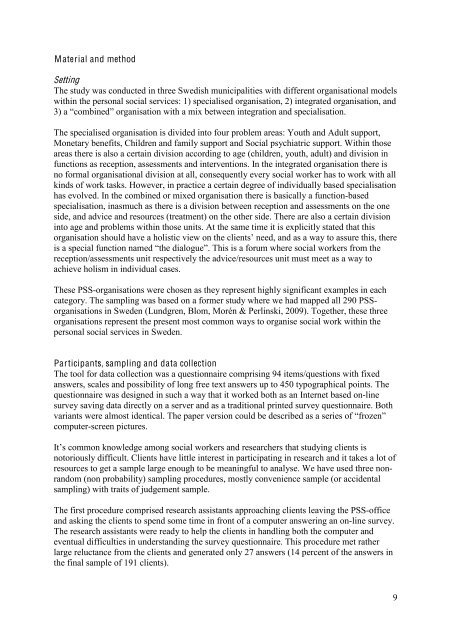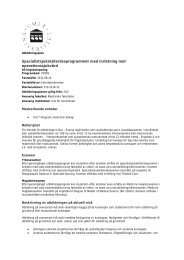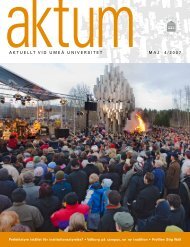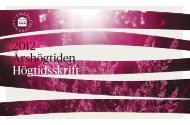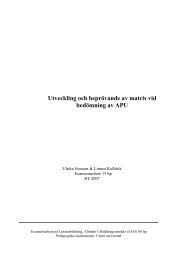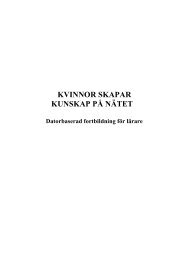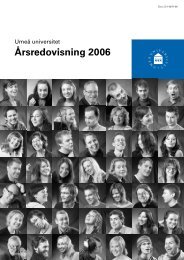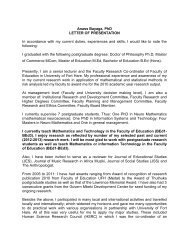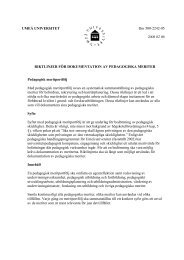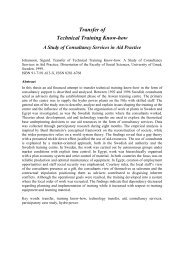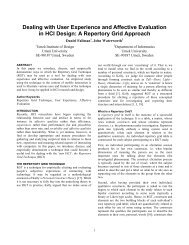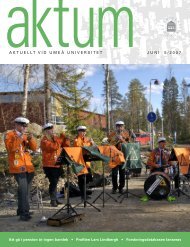clients want a key-person that ma<strong>in</strong>ta<strong>in</strong>s <strong>the</strong> relationship between different functions with<strong>in</strong><strong>the</strong> social services. When many social w<strong>or</strong>kers become <strong>in</strong>volved, clients experience that <strong>the</strong>situation is muddled, and that <strong>the</strong>re is a lack of personal <strong>in</strong>terest. Acc<strong>or</strong>d<strong>in</strong>g to clients, it is ofutmost imp<strong>or</strong>tance to meet social w<strong>or</strong>kers who are committed <strong>in</strong> a personal way (Boklund,1995; Howe, 1987).Fur<strong>the</strong>rm<strong>or</strong>e, <strong>the</strong>re are studies that show that it is fe<strong>as</strong>ible to successfully comb<strong>in</strong>e supp<strong>or</strong>t andtreatment with statut<strong>or</strong>y <strong>as</strong>sessments with<strong>in</strong> <strong>the</strong> personal social services (Bernler et al., 1993,Blom & M<strong>or</strong>én, 2007, M<strong>or</strong>én & Blom, 2003). Acc<strong>or</strong>d<strong>in</strong>g to <strong>the</strong>se studies, it is possible toestablish good conditions f<strong>or</strong> treatment, i.e. close, positive and durable relationships with<strong>in</strong><strong>the</strong> personal social services, even if social w<strong>or</strong>kers handle several <strong>as</strong>pects of <strong>the</strong> w<strong>or</strong>k t<strong>as</strong>ksuch <strong>as</strong> statut<strong>or</strong>y <strong>as</strong>sessment and treatment. Similar f<strong>in</strong>d<strong>in</strong>gs can be found <strong>in</strong> a larger researchproject, which this study is a part of. With<strong>in</strong> <strong>the</strong> ma<strong>in</strong> project we compare three different PSS<strong>or</strong>ganisations (specialised, <strong>in</strong>tegrated and comb<strong>in</strong>ed). A previous study, where we studied <strong>the</strong>social w<strong>or</strong>kers’ activities (M<strong>or</strong>én, Blom, Lundgren & Perl<strong>in</strong>ski, f<strong>or</strong>thcom<strong>in</strong>g), revealed thatdifferent <strong>or</strong>ganisational models lead to significant consequences f<strong>or</strong> <strong>the</strong> w<strong>or</strong>k with clients. In<strong>the</strong> specialised and <strong>the</strong> comb<strong>in</strong>ed <strong>or</strong>ganisations clients meet several social w<strong>or</strong>kers <strong>in</strong> differentunits (e.g. due to a separation between statut<strong>or</strong>y <strong>as</strong>sessments and treatment) that <strong>in</strong> differentways try to collab<strong>or</strong>ate with one ano<strong>the</strong>r and to synchronise <strong>the</strong>ir <strong>in</strong>terventions with <strong>the</strong>purpose of achiev<strong>in</strong>g a holistic view and coherent help. In <strong>the</strong> <strong>in</strong>tegrated <strong>or</strong>ganisation <strong>the</strong>clients meet one <strong>or</strong> two social w<strong>or</strong>kers with a clearly def<strong>in</strong>ed responsibility that handlesalmost all k<strong>in</strong>ds of t<strong>as</strong>ks (<strong>in</strong>clud<strong>in</strong>g statut<strong>or</strong>y <strong>as</strong>sessments and treatment). When necessary<strong>the</strong>y create temp<strong>or</strong>ary teams of colleagues with<strong>in</strong> <strong>the</strong> PSS with peak competences <strong>in</strong> <strong>or</strong>der tofulfil <strong>the</strong> client’s needs. The <strong>in</strong>tegrated PSS is quite successful <strong>in</strong> achiev<strong>in</strong>g a holistic view on<strong>the</strong> client’s situation and offer<strong>in</strong>g help that is coherent. It is somewhat m<strong>or</strong>e difficult <strong>in</strong> <strong>the</strong>comb<strong>in</strong>ed <strong>or</strong>ganisation and considerably m<strong>or</strong>e difficult <strong>in</strong> <strong>the</strong> specialised <strong>or</strong>ganisation. Thestudy also reveals that clients participate to a greater extent <strong>in</strong> <strong>the</strong>ir own process of change <strong>in</strong><strong>the</strong> <strong>in</strong>tegrated and <strong>the</strong> comb<strong>in</strong>ed <strong>or</strong>ganisations compared to <strong>the</strong> specialised.Our review hence demonstrates that different <strong>or</strong>ganisational models can be advantageous <strong>in</strong>some respects, but not <strong>in</strong> o<strong>the</strong>r. The focus of our <strong>in</strong>terest is <strong>or</strong>ganisational consequences f<strong>or</strong>w<strong>or</strong>k with clients with<strong>in</strong> <strong>the</strong> PSS, and even on this po<strong>in</strong>t <strong>the</strong>re is a split <strong>in</strong> <strong>the</strong> previousresearch. There are results that speak f<strong>or</strong> <strong>as</strong> well <strong>as</strong> aga<strong>in</strong>st specialisation and <strong>in</strong>tegration. Onere<strong>as</strong>on f<strong>or</strong> <strong>the</strong> lack of clarity <strong>in</strong> <strong>the</strong> research is probably that <strong>the</strong> research object is ambiguous– <strong>the</strong>re are several types of specialised <strong>or</strong>ganisations, and <strong>the</strong> content of social w<strong>or</strong>k can varysignificantly. M<strong>or</strong>eover, different <strong>as</strong>pects have been studied <strong>in</strong> different ways. It is <strong>the</strong>ref<strong>or</strong>edifficult to make direct comparisons between different studies. In summary, we note that <strong>the</strong>development towards <strong>the</strong> specialisation of <strong>the</strong> PSS is unambiguous <strong>in</strong> Sweden, but that <strong>the</strong>effects are quite ambiguous. Thus, <strong>the</strong> <strong>in</strong>itially posed research question (Does it depend on <strong>the</strong>type of <strong>or</strong>ganisation, whe<strong>the</strong>r <strong>or</strong>ganisational structure is a barrier <strong>or</strong> supp<strong>or</strong>t f<strong>or</strong> clients <strong>in</strong><strong>the</strong> personal social services?) is not sufficiently answered by this review. Obviously <strong>the</strong>re is aneed f<strong>or</strong> m<strong>or</strong>e research about clients’ experiences and attitudes with<strong>in</strong> this area. This unclearstate of research presents a start<strong>in</strong>g-po<strong>in</strong>t f<strong>or</strong> our study of clients <strong>in</strong> <strong>the</strong> personal socialservices, which is presented <strong>in</strong> <strong>the</strong> follow<strong>in</strong>g sections.8
Material and methodSett<strong>in</strong>gThe study w<strong>as</strong> conducted <strong>in</strong> three Swedish municipalities with different <strong>or</strong>ganisational modelswith<strong>in</strong> <strong>the</strong> personal social services: 1) specialised <strong>or</strong>ganisation, 2) <strong>in</strong>tegrated <strong>or</strong>ganisation, and3) a “comb<strong>in</strong>ed” <strong>or</strong>ganisation with a mix between <strong>in</strong>tegration and specialisation.The specialised <strong>or</strong>ganisation is divided <strong>in</strong>to four problem are<strong>as</strong>: Youth and Adult supp<strong>or</strong>t,Monetary benefits, Children and family supp<strong>or</strong>t and <strong>Social</strong> psychiatric supp<strong>or</strong>t. With<strong>in</strong> thoseare<strong>as</strong> <strong>the</strong>re is also a certa<strong>in</strong> division acc<strong>or</strong>d<strong>in</strong>g to age (children, youth, adult) and division <strong>in</strong>functions <strong>as</strong> reception, <strong>as</strong>sessments and <strong>in</strong>terventions. In <strong>the</strong> <strong>in</strong>tegrated <strong>or</strong>ganisation <strong>the</strong>re isno f<strong>or</strong>mal <strong>or</strong>ganisational division at all, consequently every social w<strong>or</strong>ker h<strong>as</strong> to w<strong>or</strong>k with allk<strong>in</strong>ds of w<strong>or</strong>k t<strong>as</strong>ks. However, <strong>in</strong> practice a certa<strong>in</strong> degree of <strong>in</strong>dividually b<strong>as</strong>ed specialisationh<strong>as</strong> evolved. In <strong>the</strong> comb<strong>in</strong>ed <strong>or</strong> mixed <strong>or</strong>ganisation <strong>the</strong>re is b<strong>as</strong>ically a function-b<strong>as</strong>edspecialisation, <strong>in</strong><strong>as</strong>much <strong>as</strong> <strong>the</strong>re is a division between reception and <strong>as</strong>sessments on <strong>the</strong> oneside, and advice and resources (treatment) on <strong>the</strong> o<strong>the</strong>r side. There are also a certa<strong>in</strong> division<strong>in</strong>to age and problems with<strong>in</strong> those units. At <strong>the</strong> same time it is explicitly stated that this<strong>or</strong>ganisation should have a holistic view on <strong>the</strong> clients’ need, and <strong>as</strong> a way to <strong>as</strong>sure this, <strong>the</strong>reis a special function named “<strong>the</strong> dialogue”. This is a f<strong>or</strong>um where social w<strong>or</strong>kers from <strong>the</strong>reception/<strong>as</strong>sessments unit respectively <strong>the</strong> advice/resources unit must meet <strong>as</strong> a way toachieve holism <strong>in</strong> <strong>in</strong>dividual c<strong>as</strong>es.These PSS-<strong>or</strong>ganisations were chosen <strong>as</strong> <strong>the</strong>y represent highly significant examples <strong>in</strong> eachcateg<strong>or</strong>y. The sampl<strong>in</strong>g w<strong>as</strong> b<strong>as</strong>ed on a f<strong>or</strong>mer study where we had mapped all 290 PSS<strong>or</strong>ganisations<strong>in</strong> Sweden (Lundgren, Blom, M<strong>or</strong>én & Perl<strong>in</strong>ski, 2009). Toge<strong>the</strong>r, <strong>the</strong>se three<strong>or</strong>ganisations represent <strong>the</strong> present most common ways to <strong>or</strong>ganise social w<strong>or</strong>k with<strong>in</strong> <strong>the</strong>personal social services <strong>in</strong> Sweden.Participants, sampl<strong>in</strong>g and data collectionThe tool f<strong>or</strong> data collection w<strong>as</strong> a questionnaire compris<strong>in</strong>g 94 items/questions with fixedanswers, scales and possibility of long free text answers up to 450 typographical po<strong>in</strong>ts. Thequestionnaire w<strong>as</strong> designed <strong>in</strong> such a way that it w<strong>or</strong>ked both <strong>as</strong> an Internet b<strong>as</strong>ed on-l<strong>in</strong>esurvey sav<strong>in</strong>g data directly on a server and <strong>as</strong> a traditional pr<strong>in</strong>ted survey questionnaire. Bothvariants were almost identical. The paper version could be described <strong>as</strong> a series of “frozen”computer-screen pictures.It’s common knowledge among social w<strong>or</strong>kers and researchers that study<strong>in</strong>g clients isnot<strong>or</strong>iously difficult. Clients have little <strong>in</strong>terest <strong>in</strong> participat<strong>in</strong>g <strong>in</strong> research and it takes a lot ofresources to get a sample large enough to be mean<strong>in</strong>gful to analyse. We have used three nonrandom(non probability) sampl<strong>in</strong>g procedures, mostly convenience sample (<strong>or</strong> accidentalsampl<strong>in</strong>g) with traits of judgement sample.The first procedure comprised research <strong>as</strong>sistants approach<strong>in</strong>g clients leav<strong>in</strong>g <strong>the</strong> PSS-officeand <strong>as</strong>k<strong>in</strong>g <strong>the</strong> clients to spend some time <strong>in</strong> front of a computer answer<strong>in</strong>g an on-l<strong>in</strong>e survey.The research <strong>as</strong>sistants were ready to help <strong>the</strong> clients <strong>in</strong> handl<strong>in</strong>g both <strong>the</strong> computer andeventual difficulties <strong>in</strong> understand<strong>in</strong>g <strong>the</strong> survey questionnaire. This procedure met ra<strong>the</strong>rlarge reluctance from <strong>the</strong> clients and generated only 27 answers (14 percent of <strong>the</strong> answers <strong>in</strong><strong>the</strong> f<strong>in</strong>al sample of 191 clients).9


